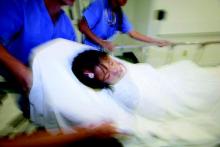Children’s and adolescents’ use of emergency departments rose markedly in the late 2000s, a sharp contrast from their steady or decreasing rates of ED use throughout the 1990s and early 2000s, according to a Research Letter to the Editor published online Oct. 14 in JAMA.
The recent uptick in pediatric ED visits also contrasts with a notable decline in adult ED use during the same time period. “These findings suggest that the drivers for ED use differ significantly between youths and adults, and that policies regarding insurance expansion” – that is, coverage through the Affordable Care Act – “may also have varying effects,” said Dr. Renee Y. Hsia of the department of emergency medicine, University of California, San Francisco, and San Francisco General Hospital, and her associates.
They performed a retrospective analysis using a database recording all ED visits by children and adolescents up to 18 years of age to general hospitals across California between 2005 and 2010. The overall number of visits rose from 2.5 million to 2.8 million per year during that period, an increase of 11%. The fastest increase in rates of ED use occurred among uninsured youths, who showed a 23% rise. The rate rose 15% among privately insured youths and 7% among youths covered by Medicaid, the investigators said (JAMA 2014;312:1587-8).
“The divergence from older trends in ED use among youths may also reflect the increasingly central role of the ED in the U.S. health care system, especially during a period of severe economic recession, and could signal an overall deterioration in access to primary care across payer groups, or that even privately insured youths with greater access to primary care physicians are being directed to the ED for care,” Dr. Hsia and her associates said.


